|
|
||
|
HOME
|
US Navy -
ships
|
US Navy - air
units
|
USMC - air
units
|
International
Navies
|
Weapon Systems
|
Special Reports |
||
|
US Navy - Guided Missile Destroyer DDG 1002 - USS Lyndon B. Johnson |
||
|
||
| 07/22 | ||
|
Type, class: Multi-Mission Guided Missile Destroyer
- DDG; Zumwalt class Builder: General Dynamics - Bath Iron Works, Bath, Maine STATUS: Awarded: September 15, 2011 Laid down: January 30, 2017 Launched: December 9, 2018 Christened: April 27, 2019 outfitting + trials Commissioned: 2024 ? I Homeport: ? Namesake: President Lyndon B. Johnson (1908-73) Ships Motto: IN DEFENSE OF GREAT SOCIETY Technical Data: see: INFO > Zumwalt class Guided Missile Destroyer - DDG |
||
| images | ||
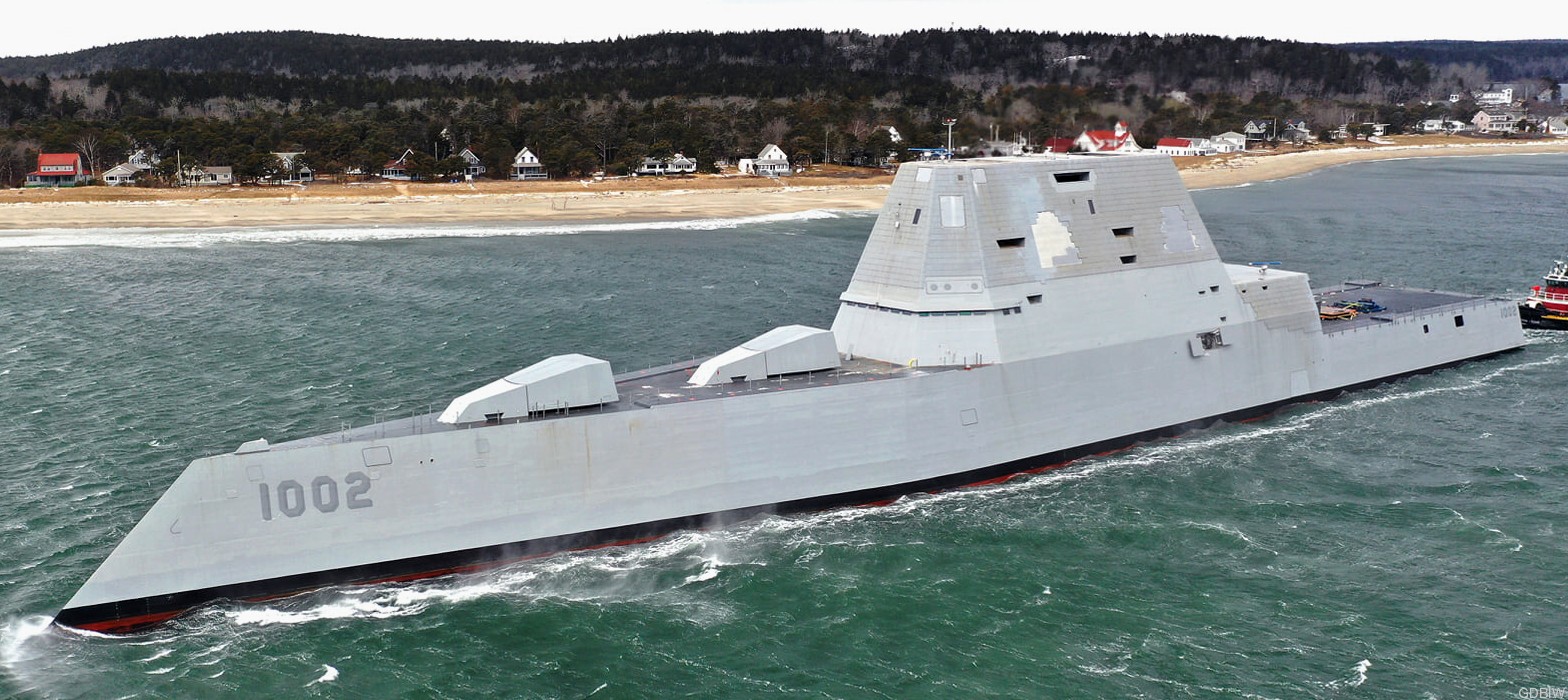 Kennebec River, Maine - January 2022 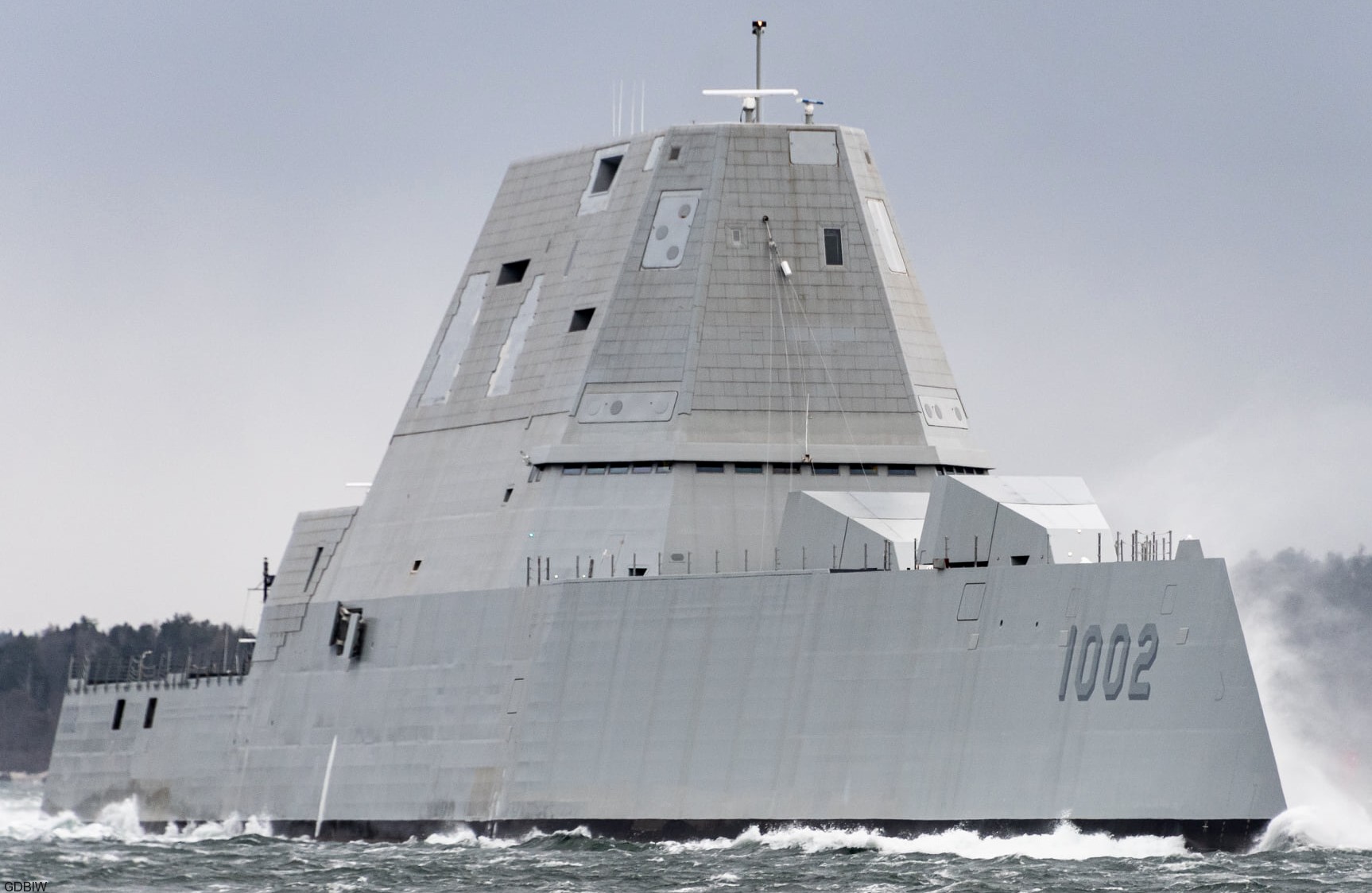 Kennebec River, Maine - January 2022 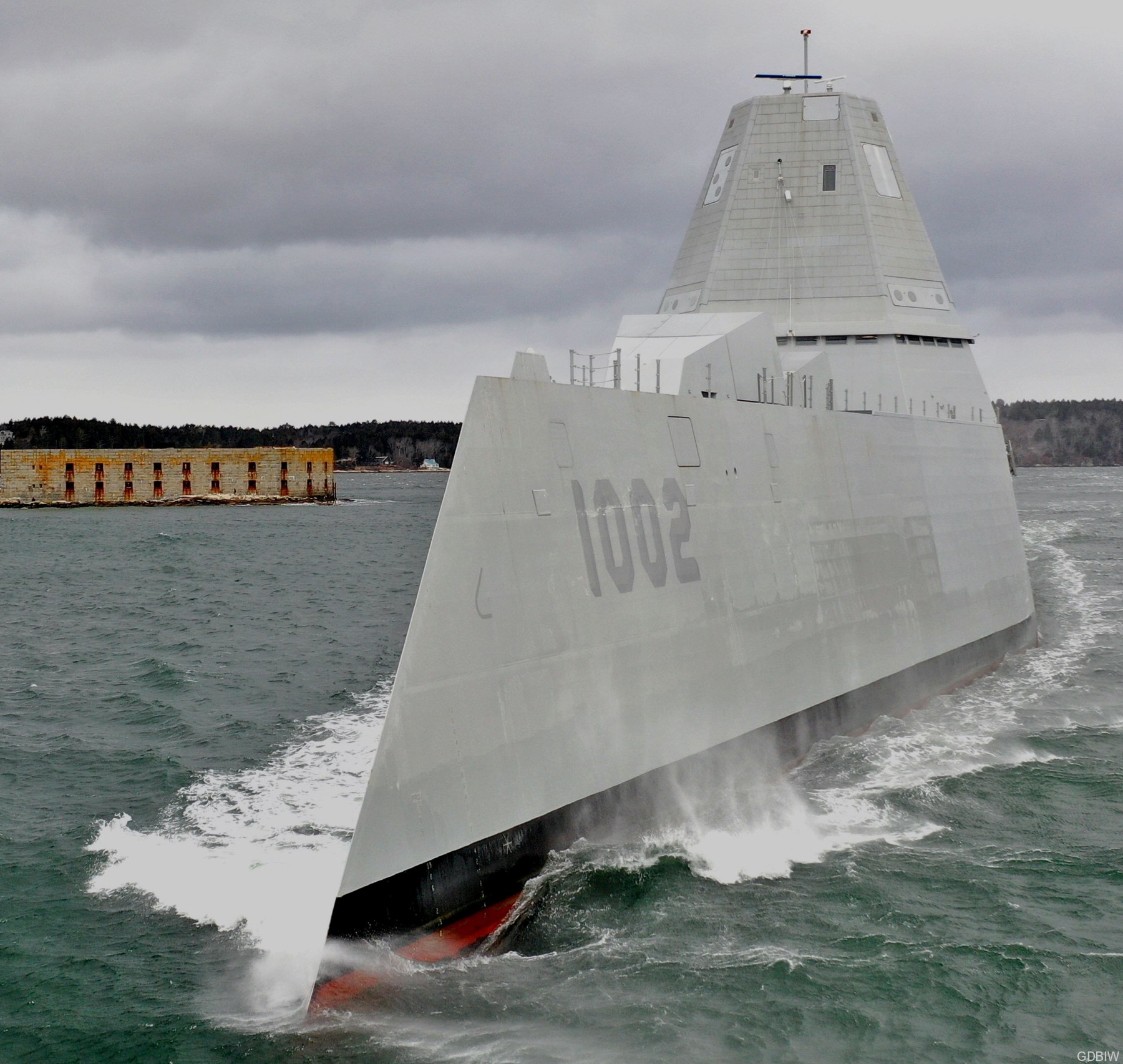 passing Fort Popham, Maine - January 2022 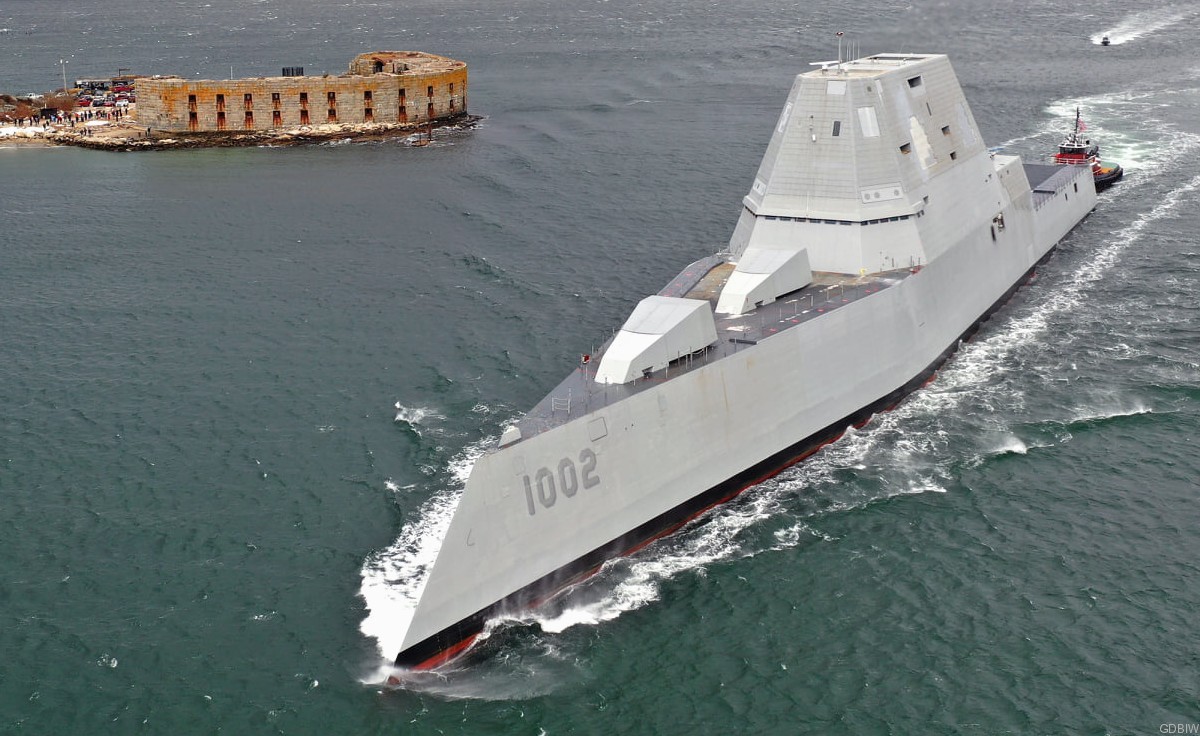 passing Fort Popham, Maine - January 2022 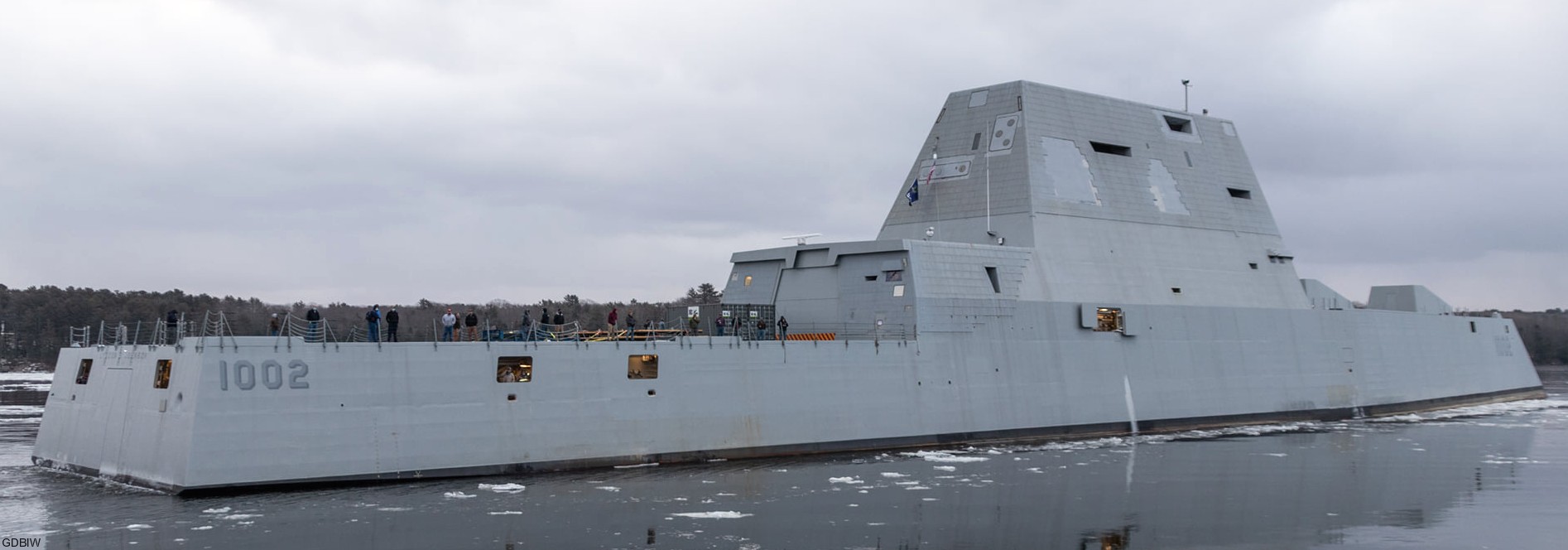 Kennebec River, Maine - January 2022 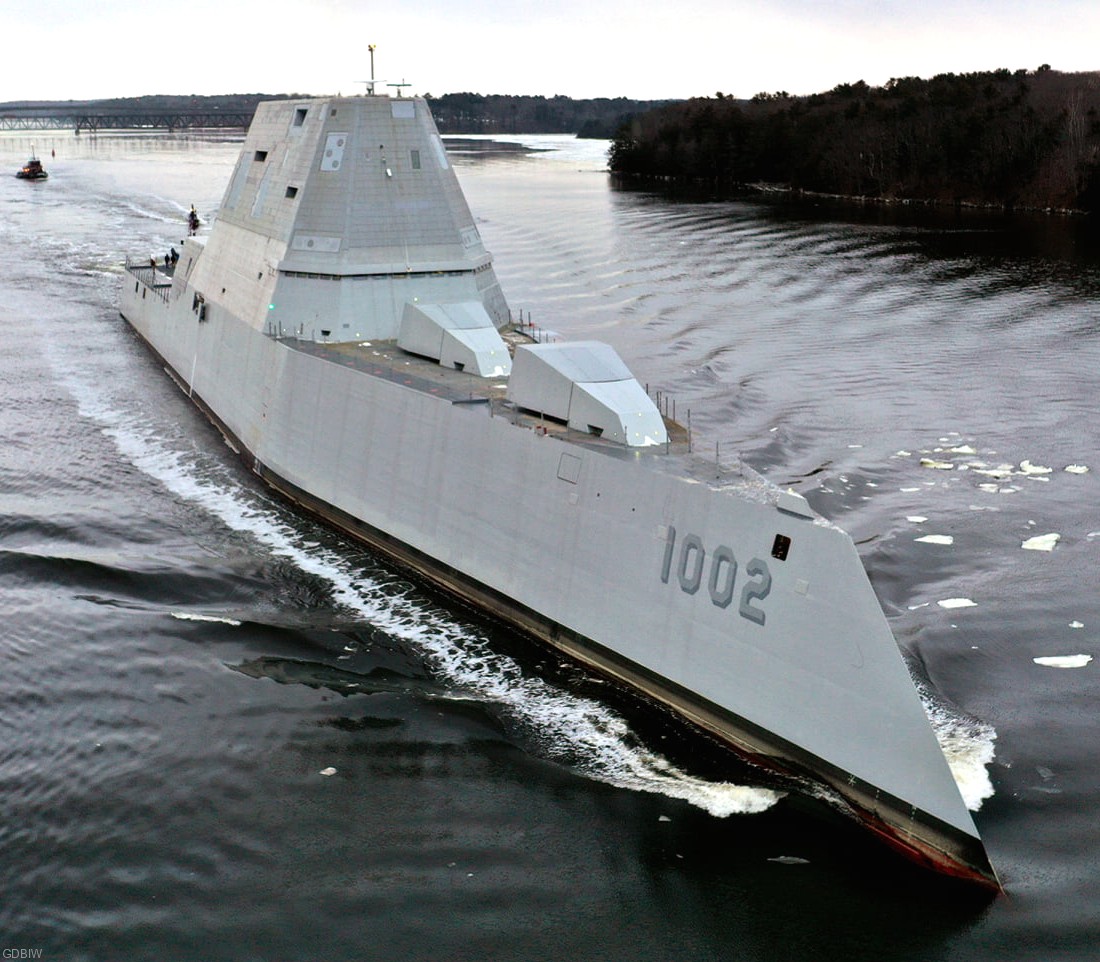 Kennebec River, Maine - January 2022 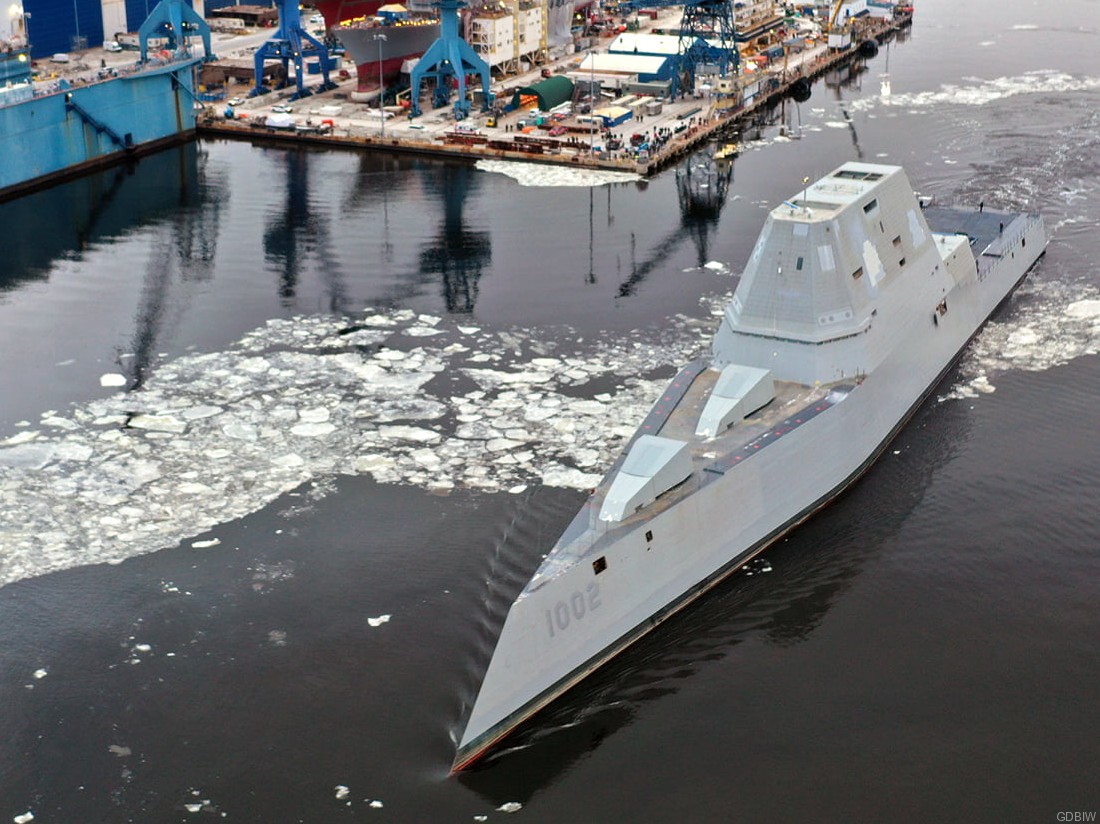 departing Bath Iron Works, Maine - January 2022 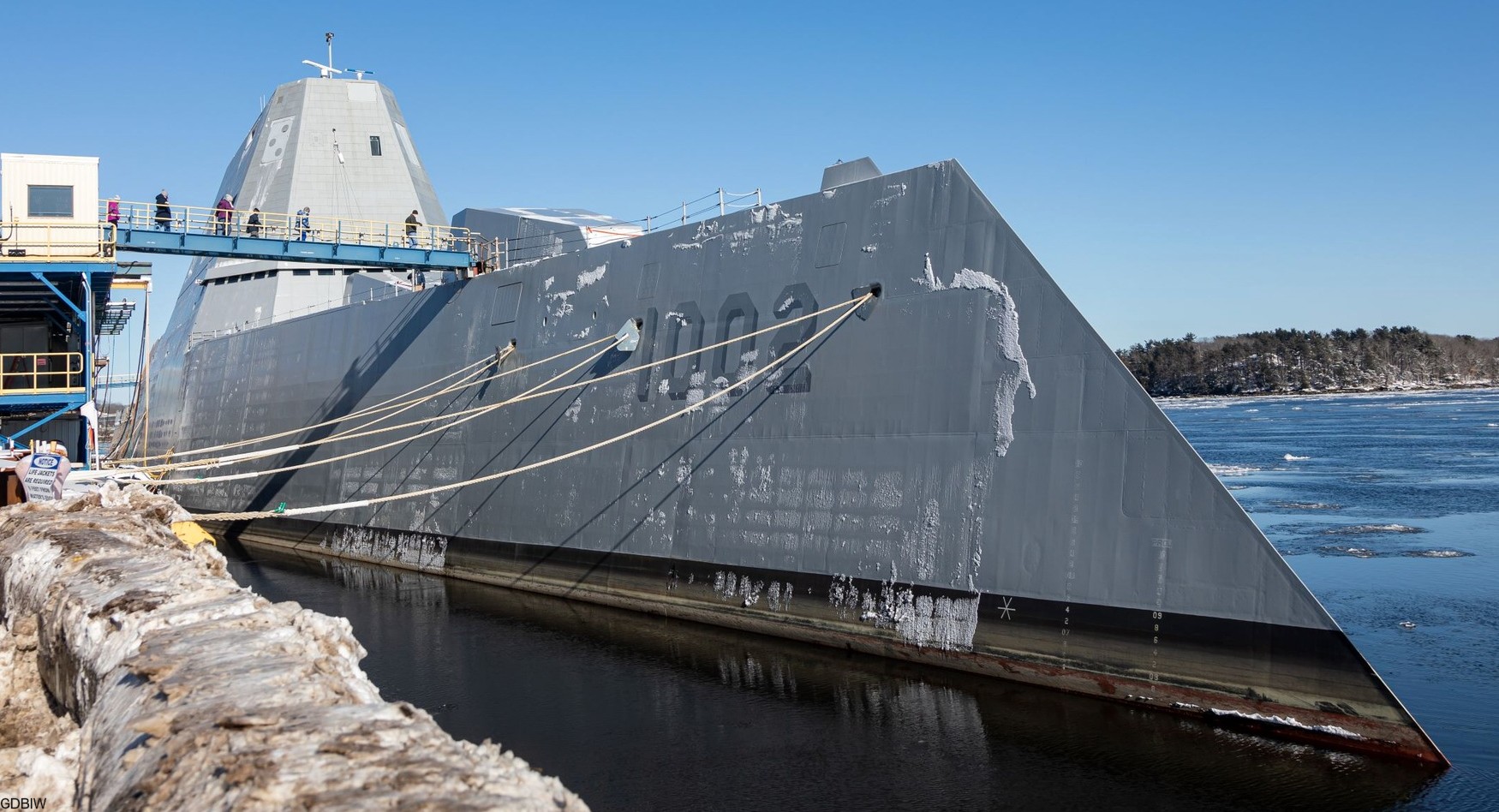 Bath Iron Works, Maine - January 2022 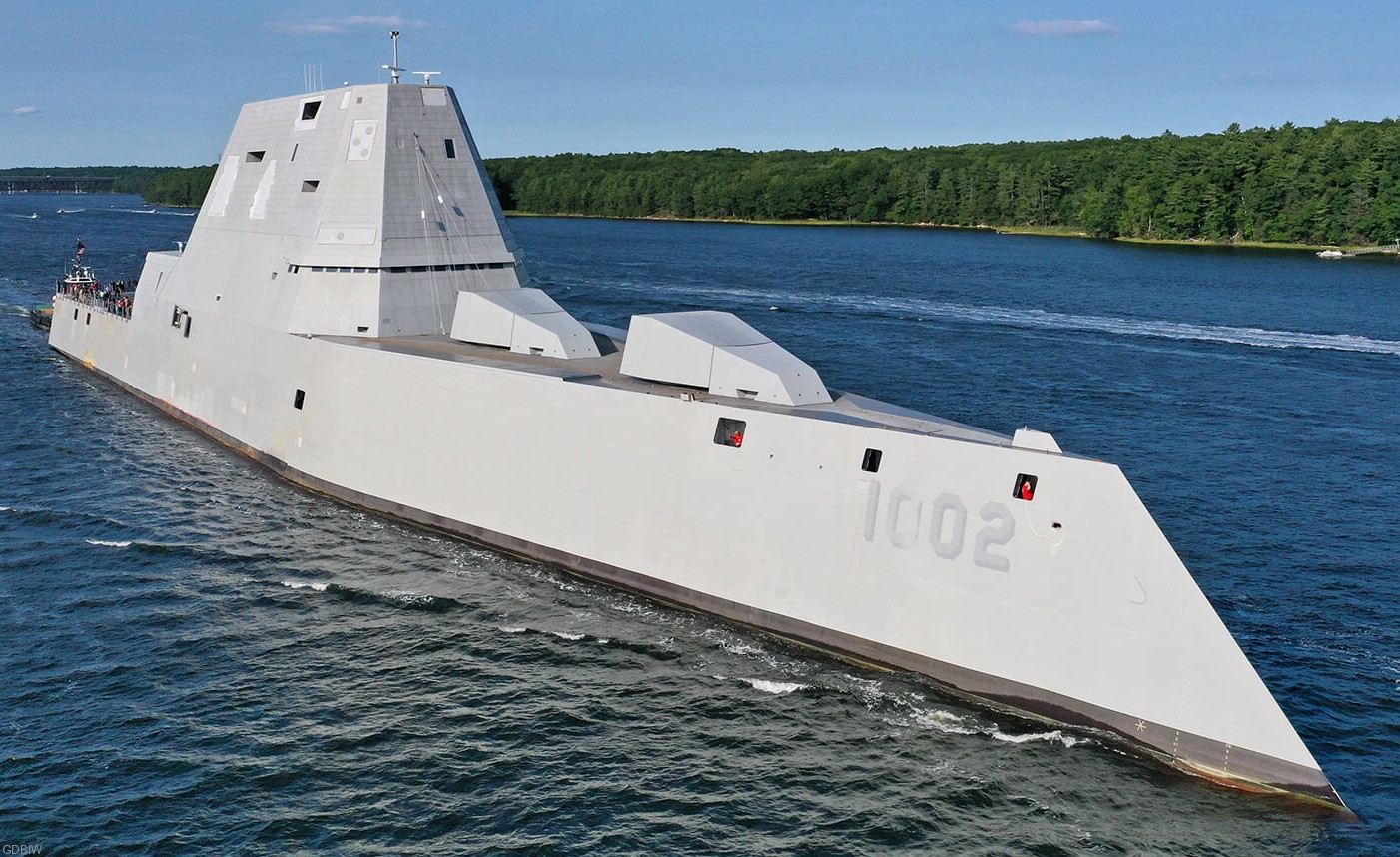 September 2021 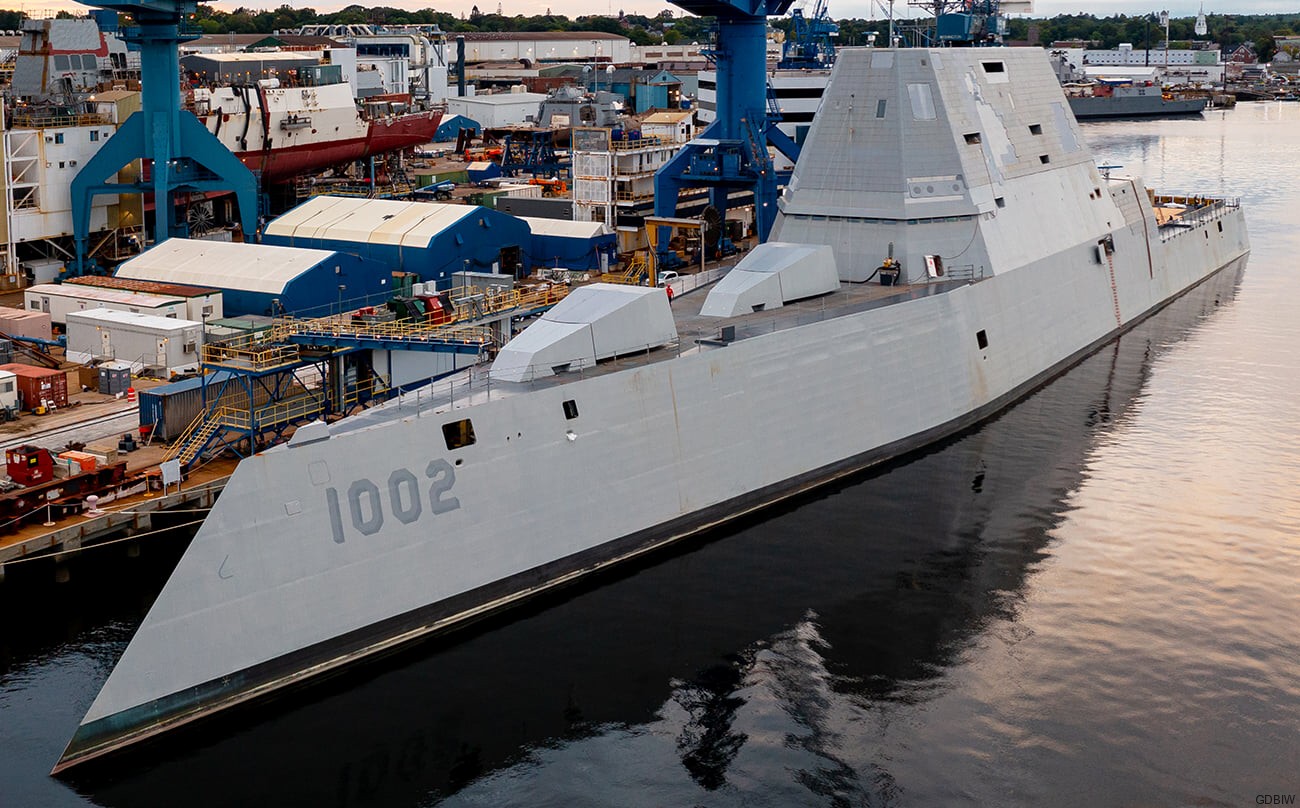 September 2021 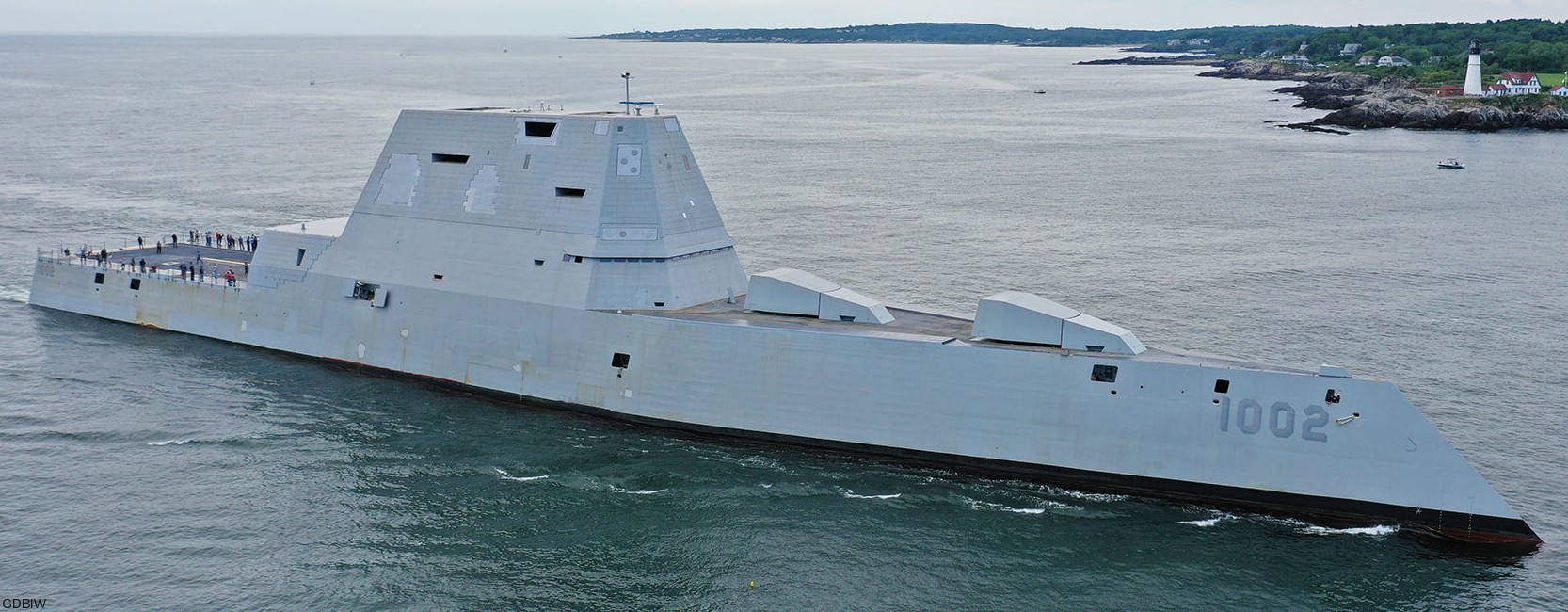 August 2021 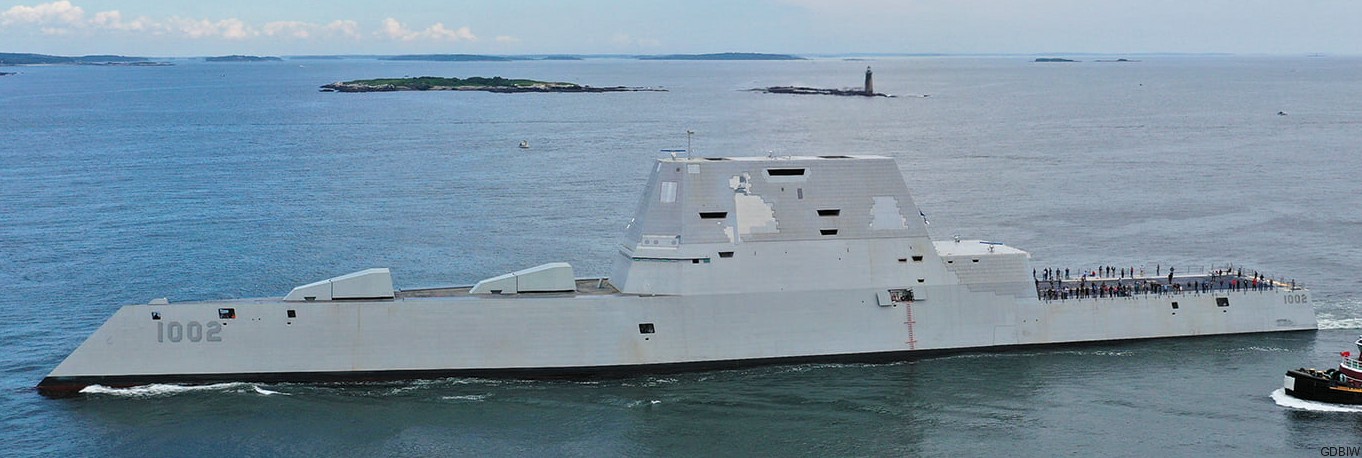 August 2021 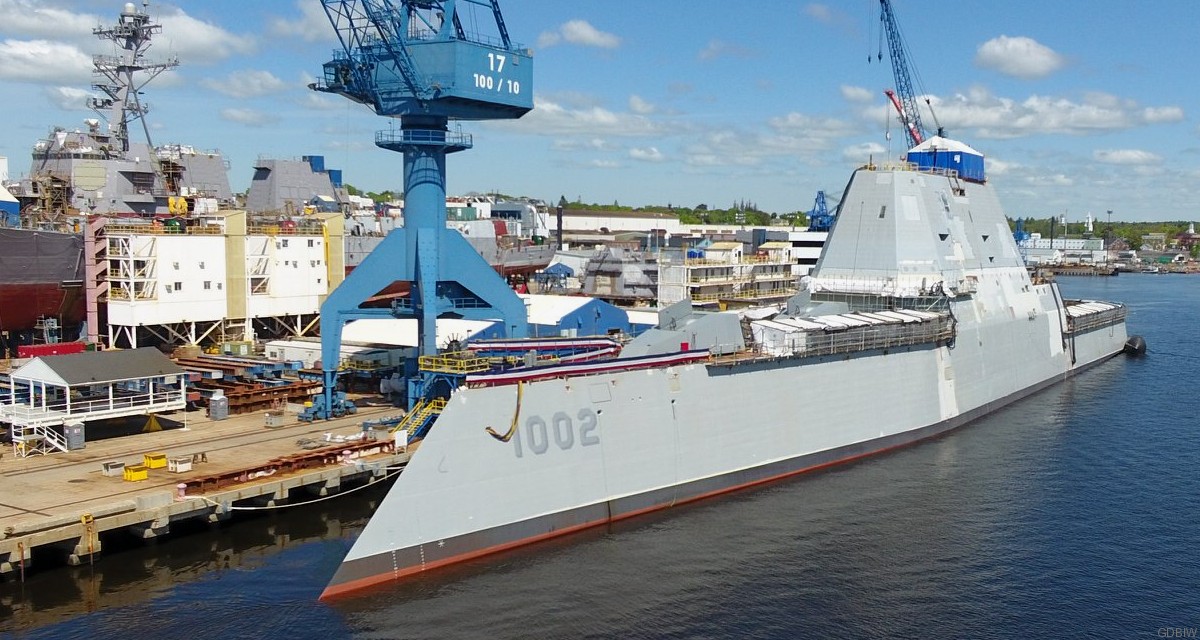 outfitting at General Dynamics Bath Iron Works, Maine - May 2020 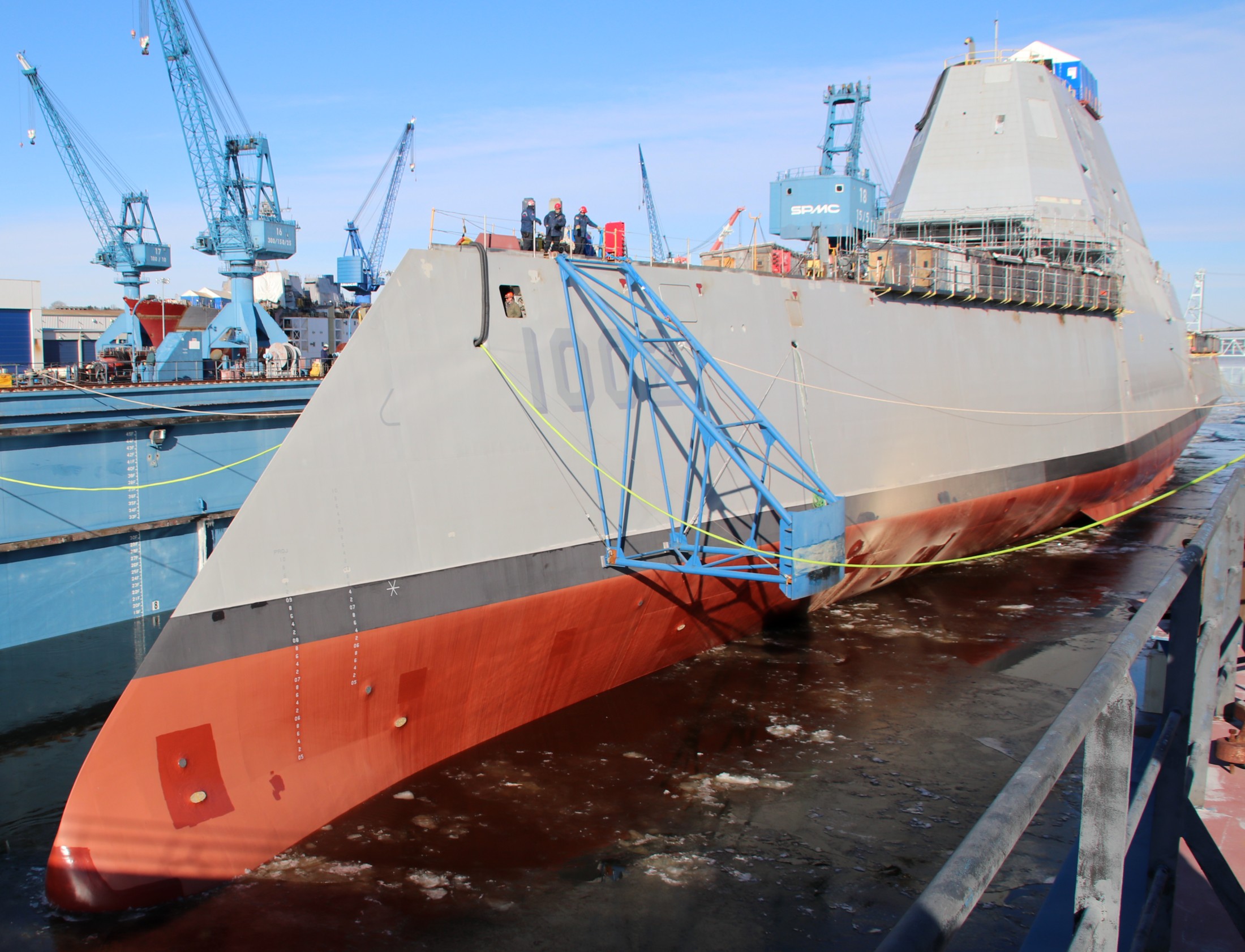 Following a multi-day process that includes moving the ship from the land level facility to the dry dock, the future USS Lyndon B. Johnson (DDG 1002) is made ready before flooding of the dry dock at General Dynamics Bath Iron Works shipyard, and subsequent launching of the ship - December 9, 2018 (GDBIW/USN) 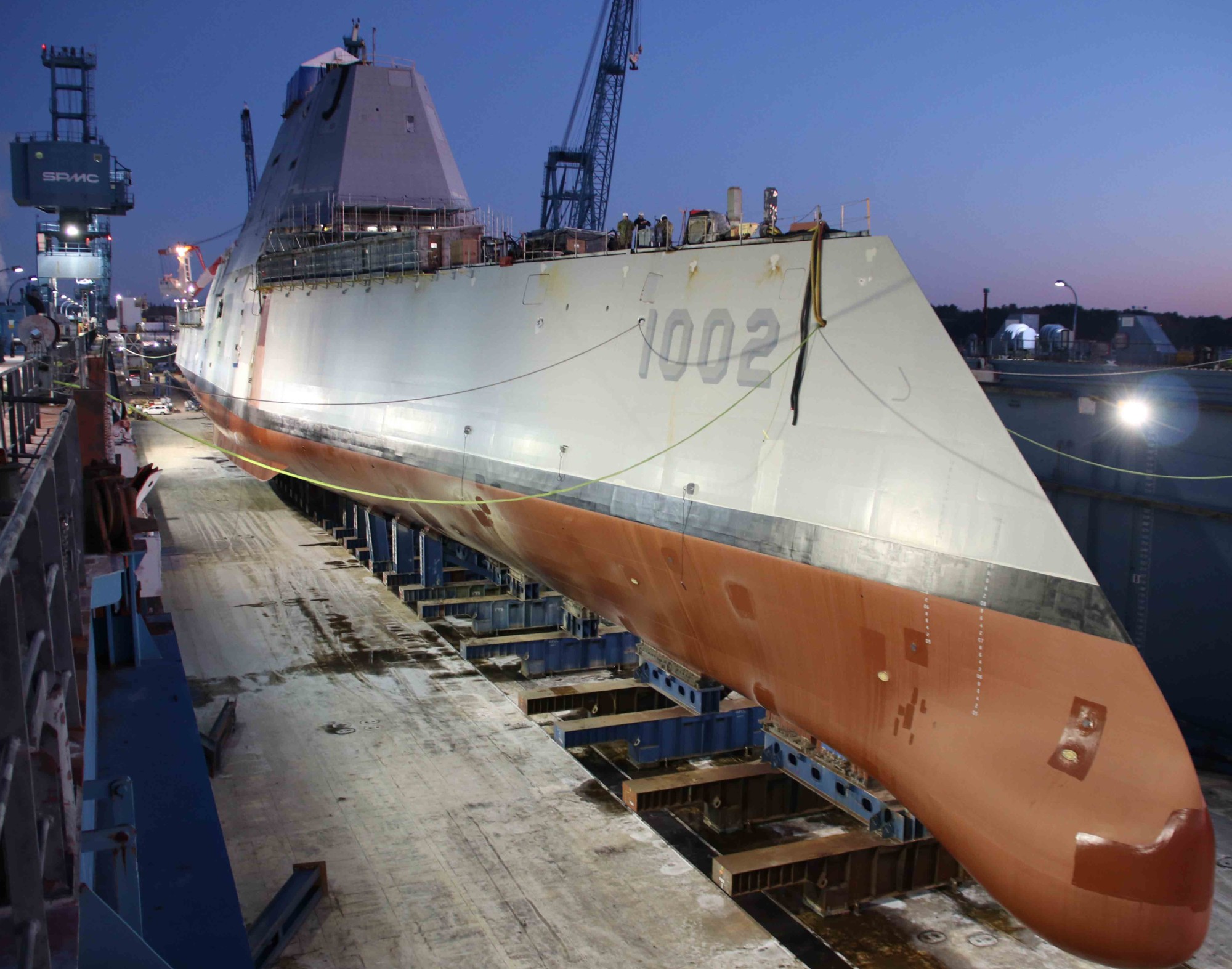 Bath Iron Works, Maine - December 9, 2018 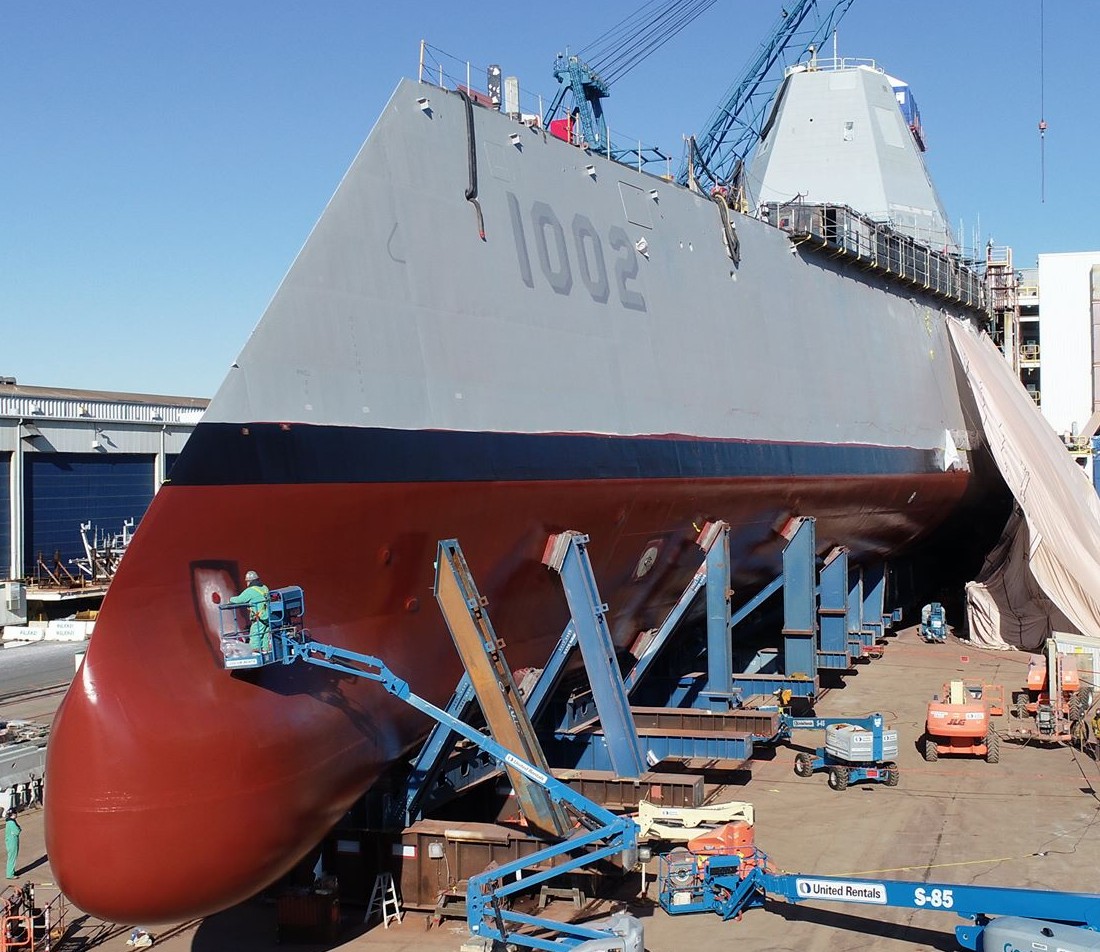 Bath Iron Works, Maine - November 2018 |
||
|
Lyndon Baines Johnson, 36th President of the United States
(August 27, 1908 - January 22, 1973): Lyndon Baines Johnson, often referred to by his initials LBJ, was an American politician who served as the 36th President of the United States from 1963 to 1969. Formerly the 37th Vice President of the United States from 1961 to 1963, he assumed the presidency following the assassination of President John F. Kennedy. A Democrat from Texas, Johnson also served as a United States Representative and as the Majority Leader in the United States Senate. Johnson is one of only four people who have served in all four federal elected positions. Born in a farmhouse in Stonewall, Texas, Johnson was a high school teacher and worked as a congressional aide before winning election to the House of Representatives in 1937. He won election to the Senate in 1948 and was appointed to the position of Senate Majority Whip in 1951. He became the Senate Minority Leader in 1953 and the Senate Majority Leader in 1955. He became known for his domineering personality and the "Johnson treatment", his aggressive coercion of powerful politicians to advance legislation. Johnson ran for the Democratic nomination in the 1960 presidential election. Although unsuccessful, he accepted the invitation of then-Senator John F. Kennedy of Massachusetts to be his running mate. They went on to win a close election over the Republican ticket of Richard Nixon and Henry Cabot Lodge Jr. On November 22, 1963, Kennedy was assassinated and Johnson succeeded him as president. The following year, Johnson won a landslide in 1964, defeating Senator Barry Goldwater of Arizona. With 61.1 percent of the popular vote, Johnson won the largest share of the popular vote of any candidate since the largely uncontested 1820 election. In domestic policy, Johnson designed the "Great Society" legislation to expand civil rights, public broadcasting, Medicare, Medicaid, aid to education, the arts, urban and rural development, public services and his "War on Poverty". Assisted in part by a growing economy, the War on Poverty helped millions of Americans rise above the poverty line during his administration. Civil-rights bills that he signed into law banned racial discrimination in public facilities, interstate commerce, the workplace and housing; the Voting Rights Act prohibited certain requirements in southern states used to disenfranchise African Americans. With the passage of the Immigration and Nationality Act of 1965, the country's immigration system was reformed, encouraging greater emigration from regions other than Europe. Johnson's presidency marked the peak of modern liberalism after the New Deal era. In foreign policy, Johnson escalated American involvement in the Vietnam War. In 1964, Congress passed the Gulf of Tonkin Resolution, which granted Johnson the power to use military force in Southeast Asia without having to ask for an official declaration of war. The number of American military personnel in Vietnam increased dramatically, from 16,000 advisors in non-combat roles in 1963 to 525,000 in 1967, many in combat roles. American casualties soared and the peace process stagnated. Growing unease with the war stimulated a large, angry anti-war movement based chiefly among draft-age students on university campuses. Johnson faced further troubles when summer riots began in major cities in 1965 and crime rates soared, as his opponents raised demands for "law and order" policies. While Johnson began his presidency with widespread approval, support for him declined as the public became frustrated with both the war and the growing violence at home. In 1968, the Democratic Party factionalized as anti-war elements denounced Johnson; he ended his bid for renomination after a disappointing finish in the New Hampshire primary. Nixon was elected to succeed him, as the New Deal coalition that had dominated presidential politics for 36 years collapsed. After he left office in January 1969, Johnson returned to his Texas ranch, where he died of a heart attack at age 64, on January 22, 1973. Johnson is ranked favorably by many historians because of his domestic policies and the passage of many major laws that affected civil rights, gun control, wilderness preservation, and Social Security, although he has also drawn substantial criticism for his escalation of the Vietnam War. source: wikipedia - - - - - another biography: "A Great Society" for the American people and their fellow men elsewhere was the vision of Lyndon B. Johnson. In his first years of office he obtained passage of one of the most extensive legislative programs in the Nation's history. Maintaining collective security, he carried on the rapidly growing struggle to restrain Communist encroachment in Viet Nam. Johnson was born on August 27, 1908, in central Texas, not far from Johnson City, which his family had helped settle. He felt the pinch of rural poverty as he grew up, working his way through Southwest Texas State Teachers College (now known as Texas State University-San Marcos); he learned compassion for the poverty of others when he taught students of Mexican descent. In 1937 he campaigned successfully for the House of Representatives on a New Deal platform, effectively aided by his wife, the former Claudia "Lady Bird" Taylor, whom he had married in 1934. During World War II he served briefly in the Navy as a lieutenant commander, winning a Silver Star in the South Pacific. After six terms in the House, Johnson was elected to the Senate in 1948. In 1953, he became the youngest Minority Leader in Senate history, and the following year, when the Democrats won control, Majority Leader. With rare skill he obtained passage of a number of key Eisenhower measures. In the 1960 campaign, Johnson, as John F. Kennedy's running mate, was elected Vice President. On November 22, 1963, when Kennedy was assassinated, Johnson was sworn in as President. First he obtained enactment of the measures President Kennedy had been urging at the time of his death - a new civil rights bill and a tax cut. Next he urged the Nation "to build a great society, a place where the meaning of man's life matches the marvels of man's labor." In 1964, Johnson won the Presidency with 61 percent of the vote and had the widest popular margin in American history - more than 15,000,000 votes. The Great Society program became Johnson's agenda for Congress in January 1965: aid to education, attack on disease, Medicare, urban renewal, beautification, conservation, development of depressed regions, a wide-scale fight against poverty, control and prevention of crime and delinquency, removal of obstacles to the right to vote. Congress, at times augmenting or amending, rapidly enacted Johnson's recommendations. Millions of elderly people found succor through the 1965 Medicare amendment to the Social Security Act. Under Johnson, the country made spectacular explorations of space in a program he had championed since its start. When three astronauts successfully orbited the moon in December 1968, Johnson congratulated them: "You've taken ... all of us, all over the world, into a new era. . . . " Nevertheless, two overriding crises had been gaining momentum since 1965. Despite the beginning of new antipoverty and anti-discrimination programs, unrest and rioting in black ghettos troubled the Nation. President Johnson steadily exerted his influence against segregation and on behalf of law and order, but there was no early solution. The other crisis arose from Viet Nam. Despite Johnson's efforts to end Communist aggression and achieve a settlement, fighting continued. Controversy over the war had become acute by the end of March 1968, when he limited the bombing of North Viet Nam in order to initiate negotiations. At the same time, he startled the world by withdrawing as a candidate for re-election so that he might devote his full efforts, unimpeded by politics, to the quest for peace. When he left office, peace talks were under way; he did not live to see them successful, but died suddenly of a heart attack at his Texas ranch on January 22, 1973. |
||
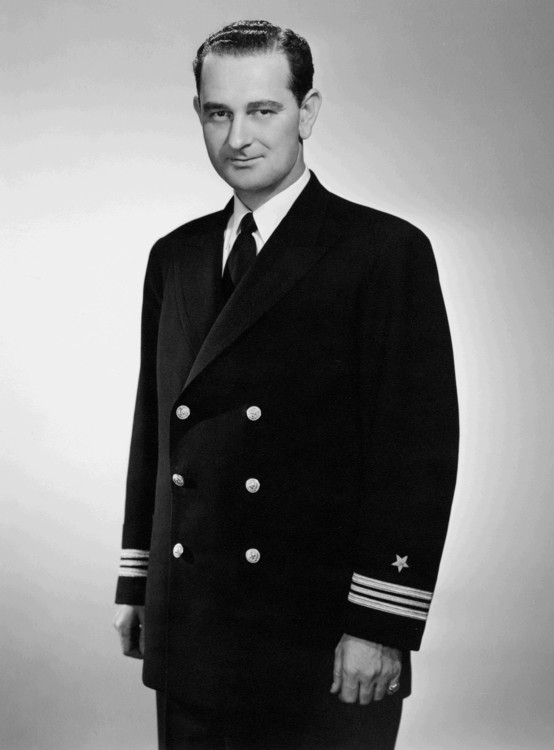 Lyndon B. Johnson in Navy Uniform - 1942 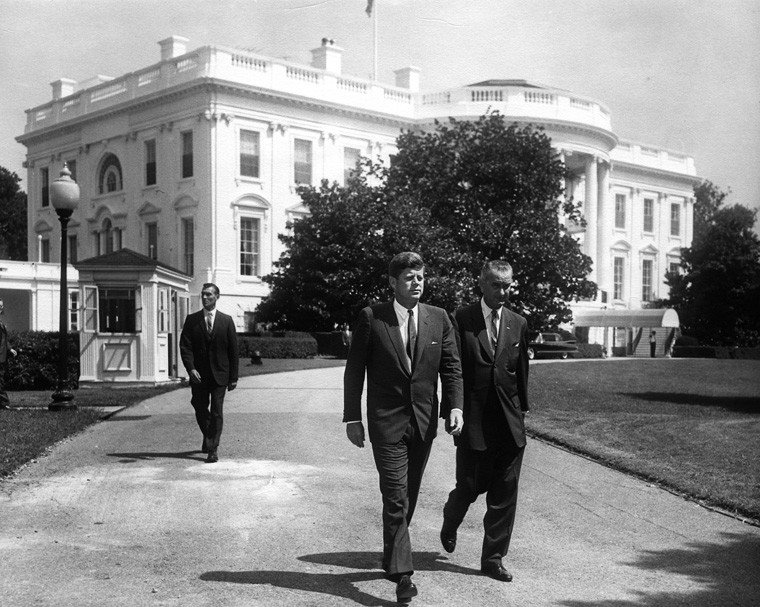 President John F. Kennedy and Vice President Lyndon B. Johnson - White House - August 1961 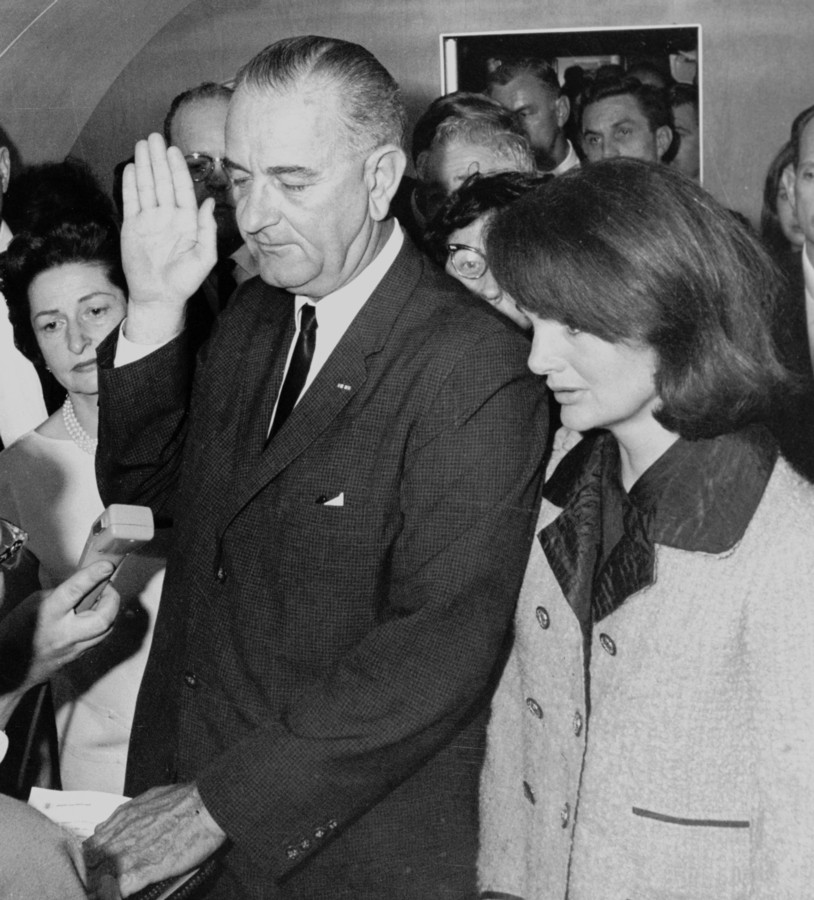 Lyndon B. Johnson taking the oath of office on Air Force One at Love Field Airport two hours and eight minutesafter the assassination of John F. Kennedy, Dallas, Texas - November 22, 1963 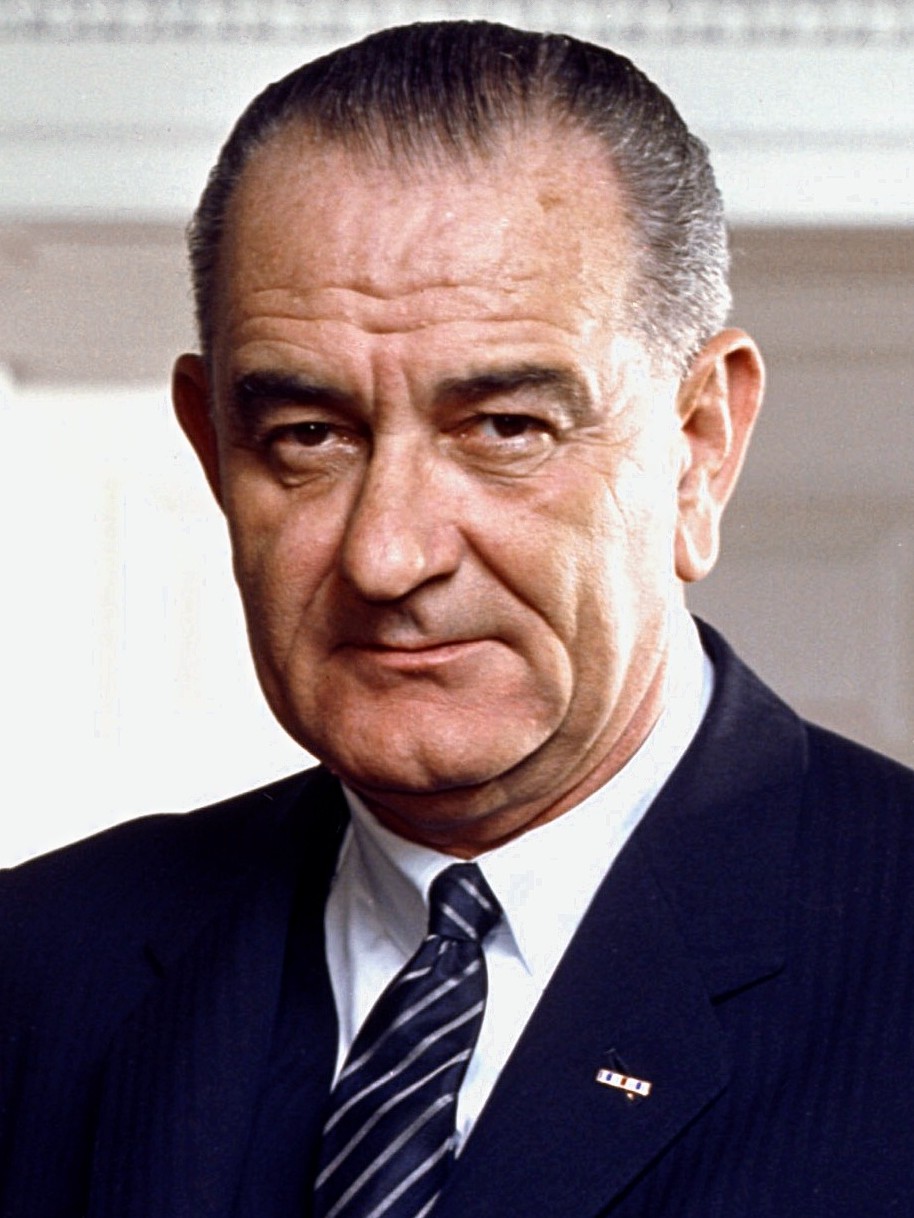 1964 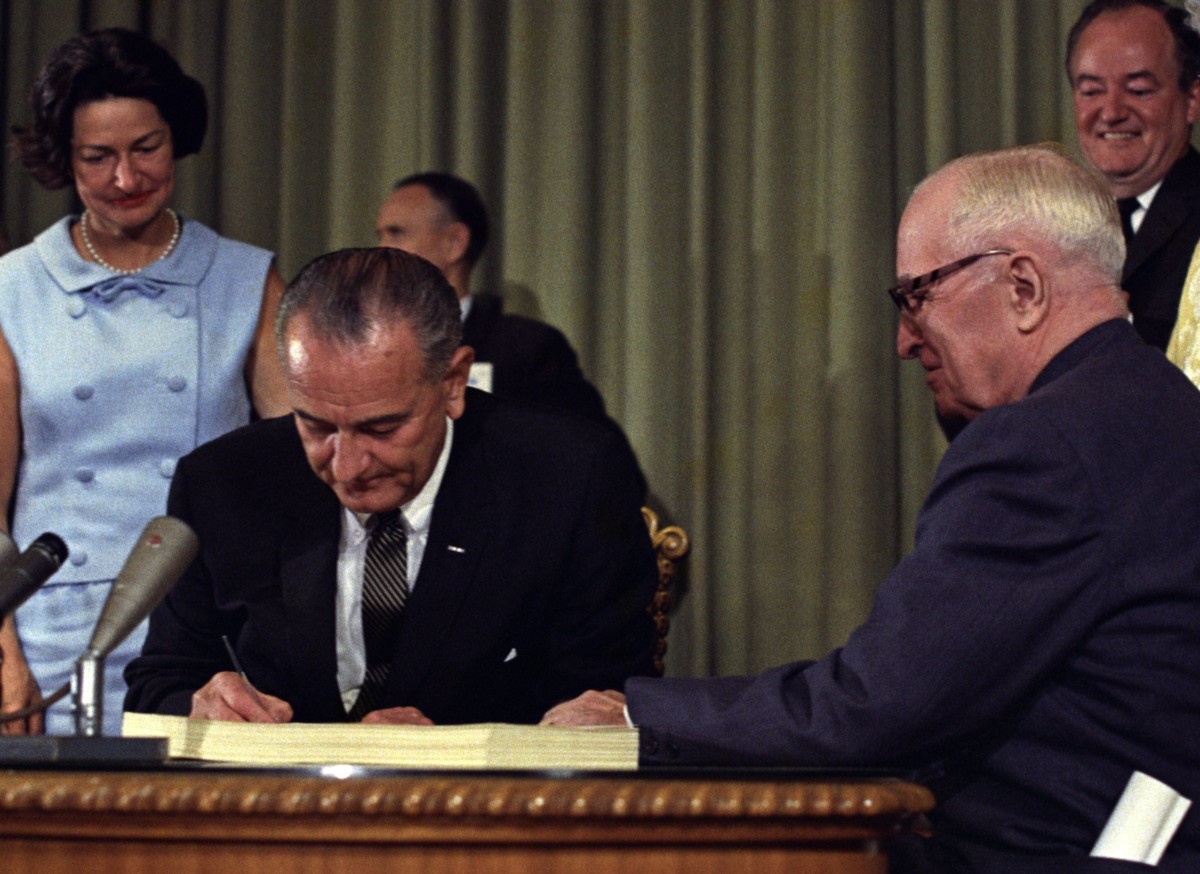 President Lyndon B. Johnson signing the Medicare Bill at the Harry S. Truman Library in Independence, Missouri. Former president Harry S. Truman is seated at the table with President Johnson - July 1965 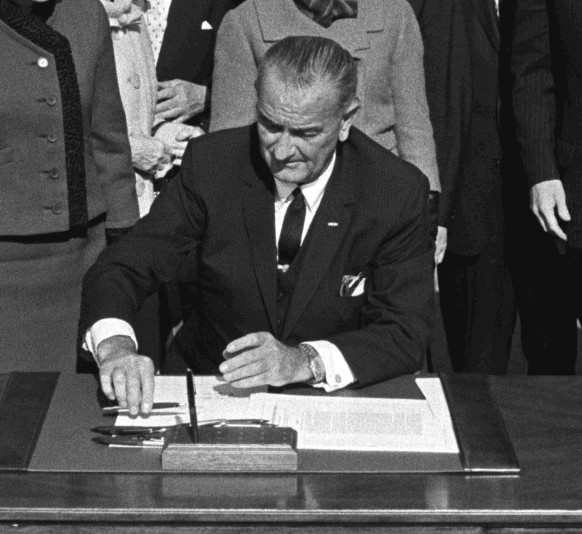 1965 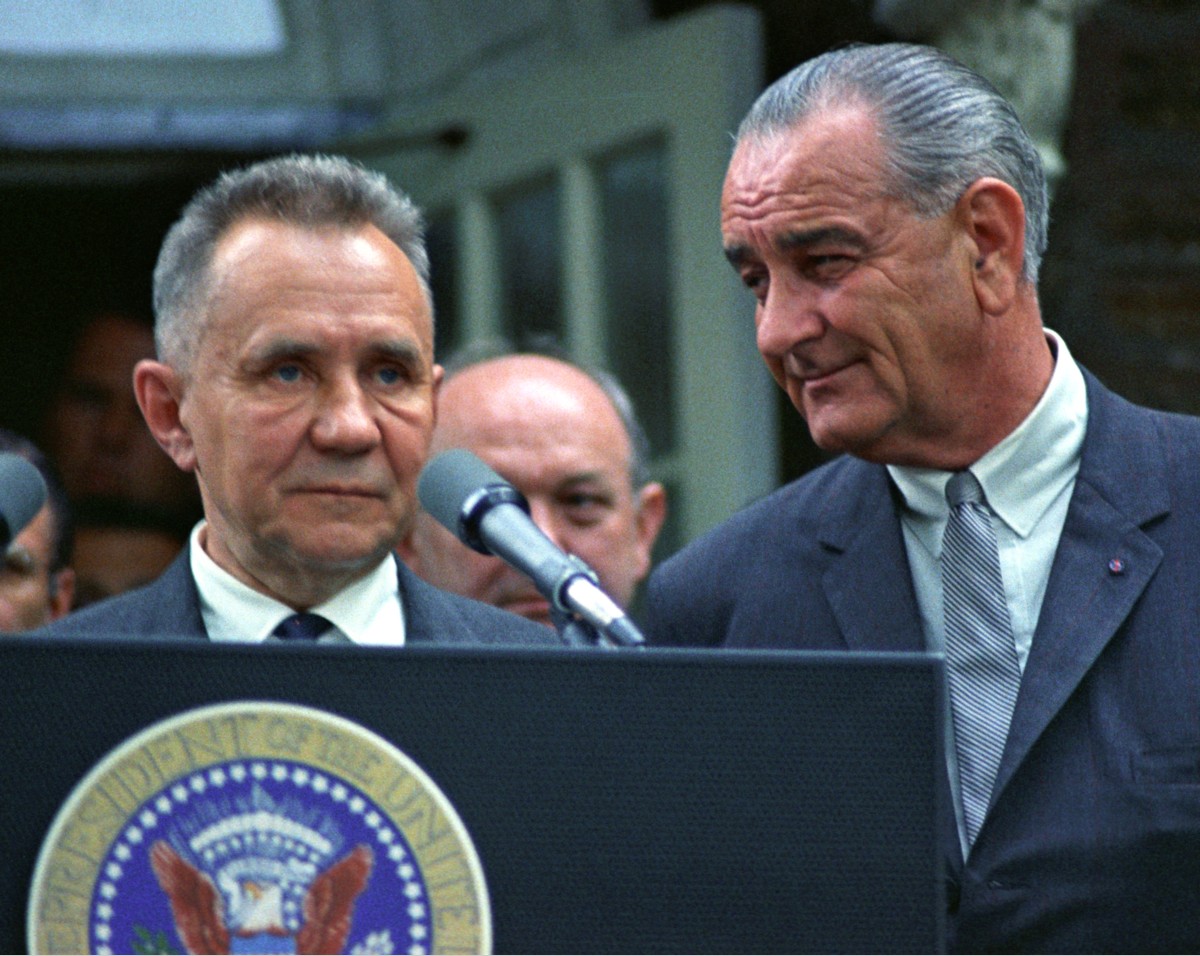 Soviet Premier Alexei Kosygin (l) and President Lyndon B. Johnson - 1967 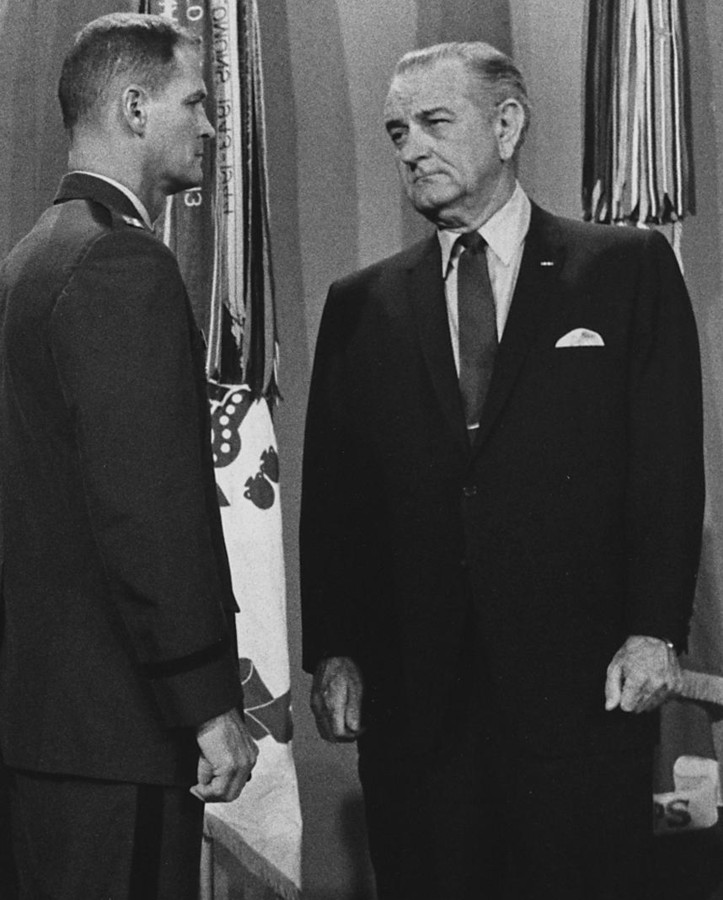 1968 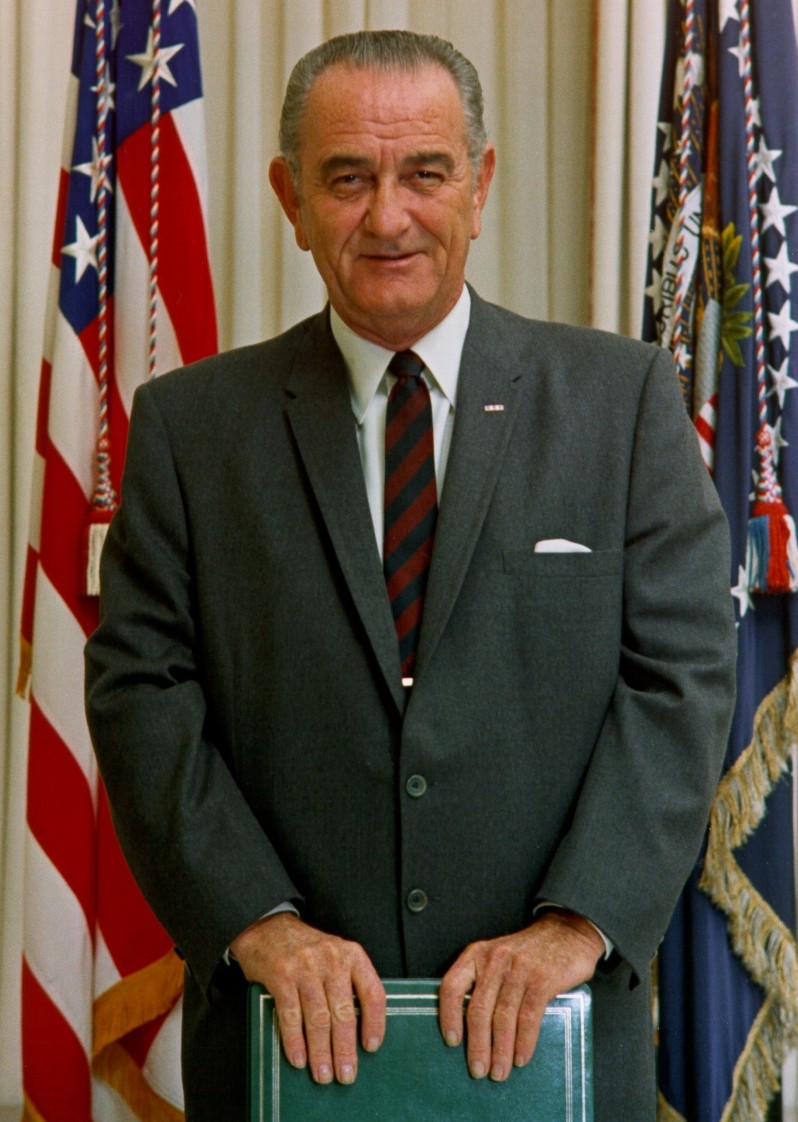 1969 |
||
|
USS Lyndon B. Johnson (DDG 1002): USS Lyndon B. Johnson (DDG-1002) is the third and final Zumwalt-class destroyer built for the United States Navy. The contract to build her was awarded to Bath Iron Works located in Bath, Maine, on 15 September 2011. The award, along with funds for the construction of USS Michael Monsoor, was worth US$1.826 billion. On 16 April 2012, Secretary of the Navy Ray Mabus announced the ship would be named Lyndon B. Johnson in honor of Lyndon B. Johnson, who served as the 36th President of the United States from 1963 to 1969. Johnson served in the Navy during World War II, when he was awarded the Silver Star, and ultimately reached the U.S. Naval Reserve rank of commander. DDG-1002 is the 34th ship named by the Navy after a U.S. president. Although 32 ships were originally planned for that class of ship, the U.S. Navy eventually reduced this number to three units. Designed as multi-mission ships with an emphasis on land attack and littoral warfare, the class features the tumblehome hull form, reminiscent of ironclad warships. In January 2013, the Navy solicited bids for a steel deckhouse as an option for Lyndon B. Johnson instead of the composite structures of the other ships in the class. This change was made in response to cost overruns for the composite structure, but due to the tight weight margins in the class, this required weight savings in other parts of the ship. In February 2015, the Navy revealed they had begun engineering studies to include an electromagnetic railgun on Lyndon B. Johnson. The Zumwalt class has been identified as more suited to use emerging technologies, like railguns, due to its superior electricity generation capability over previous destroyers and cruisers at 80 megawatts; Lyndon B. Johnson specifically was being studied because it is the latest of the class, while the previous two ships would be less likely to initially field the capability due to the testing schedule. The railgun would likely replace one of the two Advanced Gun Systems. By March 2016, construction had become too far along to install the railgun during building, but it can still be added later. In September 2015, it was reported that U.S. Department of Defense officials were considering terminating funding for Lyndon B. Johnson prior to her completion. Although considered as a cost-saving measure, cancelling the third Zumwalt ship at that stage was likely not possible, and might have ended up actually costing more after paying program shutdown costs and contract termination penalties. By December 2015, the Pentagon had decided in favor of keeping the ship. The ship's two AGSs can only fire the LRLAP round. LRLAP procurement was cancelled in 2016, and the Navy has no plan to replace it. As such, the guns cannot be used and the ship cannot provide naval gunfire support. The Navy has re-purposed the Zumwalt class to surface warfare. The ceremonial keel laying of Lyndon B. Johnson took place on 30 January 2017, by which time construction of the ship was over half finished. The ship was launched in Bath, Maine, on 9 December 2018, and christened on 27 April 2019, by Johnson's daughters, Luci and Lynda. On 12 January 2022, the ship left Bath for Ingalls Shipbuilding in Pascagoula, Mississippi, where combat systems will be activated, with entry into service reportedly expected in 2024. |
||
| patches + more | ||
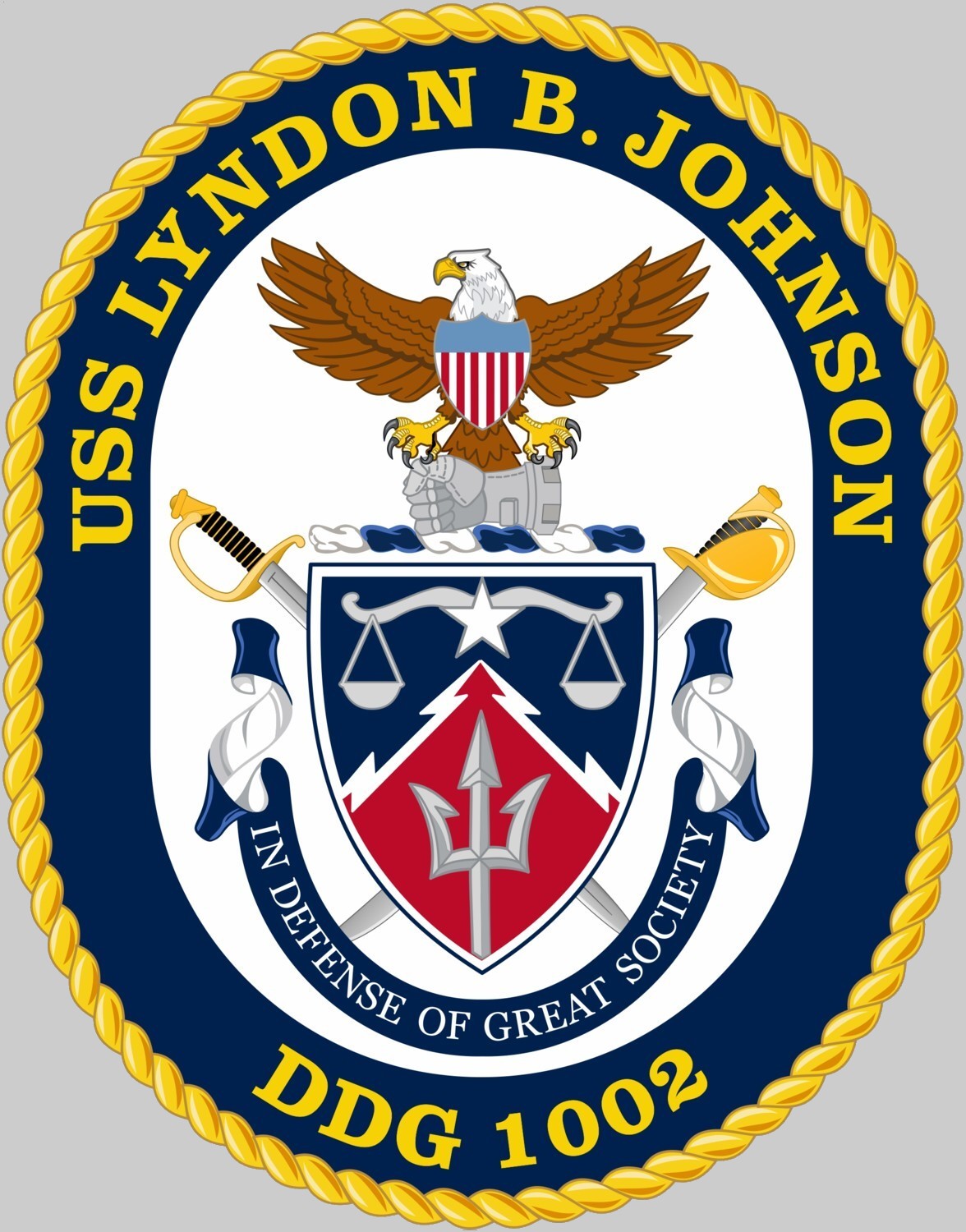 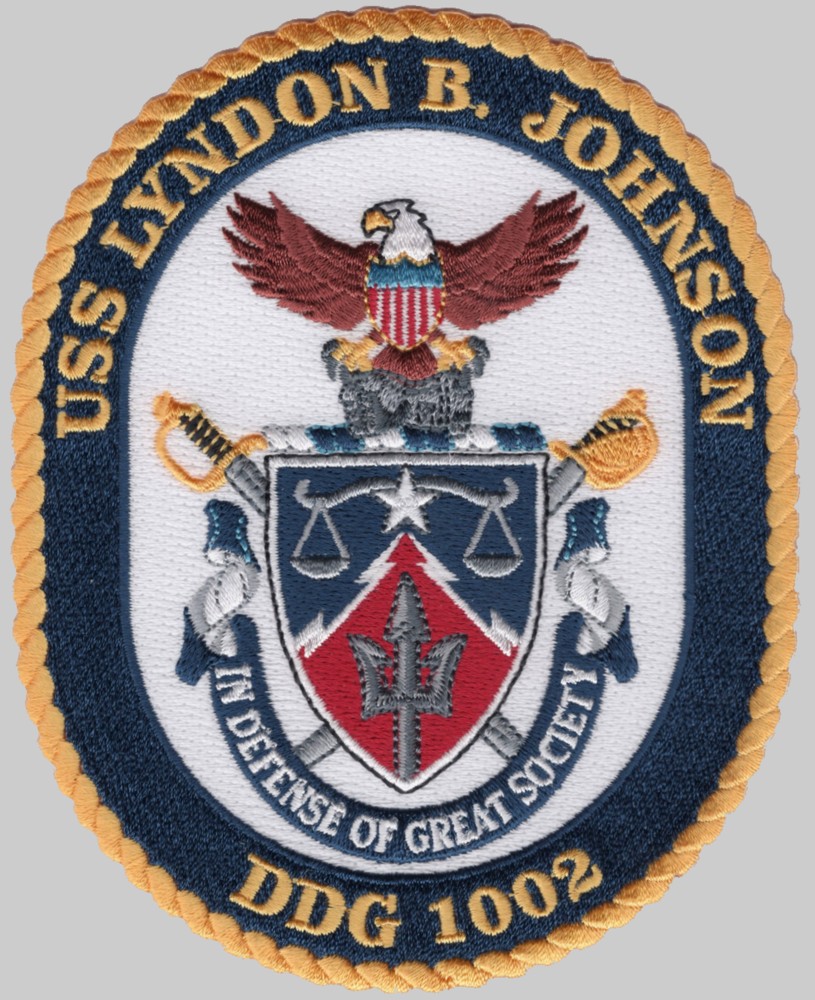 |
||
| | seaforces.org | USN ships start page | |
